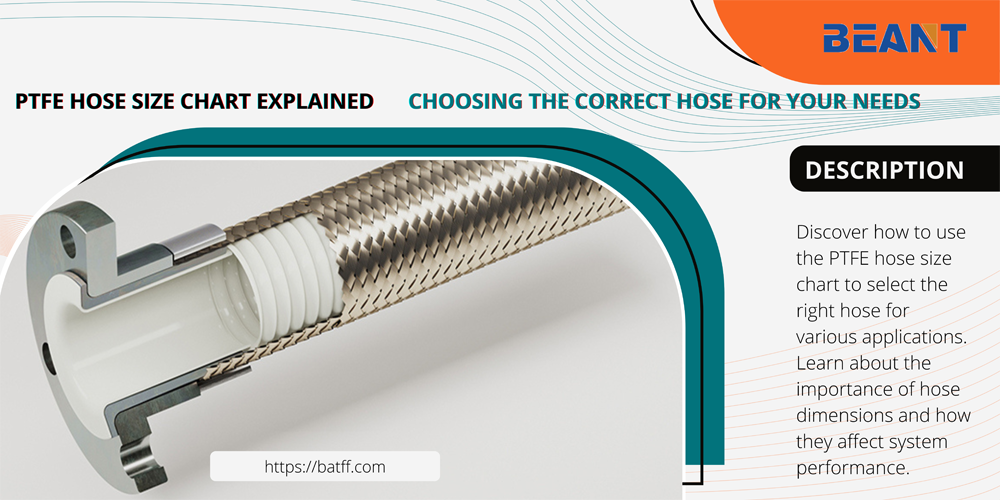
In the world of fluid transfer, Polytetrafluoroethylene (PTFE) hoses represent the pinnacle of performance and reliability. Known for their exceptional chemical resistance and temperature stability, PTFE hoses are a popular choice in a variety of industries, from automotive to pharmaceuticals. But selecting the right hose for a specific application is not just about material; size plays a critical role in ensuring efficient and safe operation.
Choosing the correct hose size is vital to prevent pressure drops, leaks, and even hose failure. The PTFE hose size chart is an essential tool that helps users select the correct hose by providing key dimensions such as the inner diameter (ID), outer diameter (OD), and wall thickness. These measurements are crucial because they directly affect the flow rate and pressure capacity of the hose.
Understanding these dimensions and how they correlate with the requirements of your system will help ensure that your setup operates at peak efficiency, with minimal downtime and maintenance. Whether you're dealing with high-pressure hydraulics or delicate chemical transfers, the right PTFE hose can make all the difference.
A PTFE hose size chart is a detailed guide that specifies the dimensions of PTFE hoses, including the inner diameter (ID), outer diameter (OD), and wall thickness. These charts are crucial for users to select the appropriate hose size for their specific applications, ensuring optimal flow and performance while maintaining the integrity of the hose under various operating conditions.
Inner Diameter (ID):
This is the measurement of the open space within the hose. The ID is a critical factor because it determines the flow rate of the fluid or gas through the hose. A hose with a too small ID can result in high pressure loss and inefficient operation, while a too large ID can cause low flow velocity, leading to sedimentation and poor system performance.
Typical IDs for PTFE hoses range from 1/8 inch to 6 inches. Smaller diameters are commonly used in applications requiring precise flow control, such as in laboratory equipment or fuel lines. Larger diameters are used in industrial applications where large volumes of fluids need to be transferred efficiently.
Outer Diameter (OD):
The OD measures the total width of the hose, including the wall. This dimension is important for fitting the hose into various types of equipment and ensuring it can handle the required pressures. The OD must be compatible with the connectors and clamps used to secure the hose in place.
Typical ODs can range from slightly larger than the ID to several inches, depending on the hose construction and application. For instance, hoses used in high-pressure situations will have thicker walls to withstand the stress.
Wall Thickness:
This is the thickness of the hose wall and is key to determining the hose's pressure rating and flexibility. A thicker wall increases the pressure capacity but reduces the flexibility of the hose, which can be crucial in applications requiring the hose to navigate tight spaces.
Wall thickness typically ranges from 1/32 inch to 1 inch, depending on the hose diameter and application. Thinner walls are favored for high-flexibility applications, while thicker walls are used where high pressure resistance is needed.
To effectively use a PTFE hose size chart, follow these steps:
1.Determine the Required Flow Rate and Pressure:
Before selecting a hose, understand the flow rate and pressure requirements of your system. These parameters will help you choose the correct ID and wall thickness to handle the expected stress without excessive pressure loss.
2.Measure the Required Hose Length:
Consider the path the hose will take between connections. Measure the required length, keeping in mind that a longer hose will have more pressure drop. If the hose needs to bend, ensure the radius can accommodate this without kinking, which could obstruct flow.
3.Select the Hose Based on Compatibility:
Use the size chart to find a hose with an ID that matches your flow rate needs and an OD and wall thickness that fit your connection types and meet your pressure requirements.
4.Check for Chemical Compatibility:
Ensure that the PTFE hose is compatible with the fluids or gases it will carry. PTFE is generally resistant to most chemicals, but checking specific compatibility charts is always recommended.
5.Consult with Manufacturers for Custom Sizes:
If the standard sizes do not meet your needs, consult with hose manufacturers for custom dimensions.
Here is a simplified example of what a PTFE hose size chart might look like:
| Hose Size | Inner Diameter (ID) | Outer Diameter (OD) | Wall Thickness | Max Working Pressure |
|---|---|---|---|---|
| 1/8" | 0.125" | 0.250" | 0.0625" | 3000 psi |
| 1/4" | 0.250" | 0.375" | 0.0625" | 2500 psi |
| 1/2" | 0.500" | 0.648" | 0.074" | 2000 psi |
| 1" | 1.000" | 1.173" | 0.0865" | 1000 psi |
| 2" | 2.000" | 2.240" | 0.120" | 800 psi |
PTFE hoses are versatile and can be used in various industries due to their robust chemical resistance, thermal stability, and flexibility. The size of the hose plays a critical role in determining its suitability for specific applications. Here’s how different sizes of PTFE hoses are used across various sectors:
Small Diameter Hoses (1/8” to 1/4” ID):
These are typically used for fuel lines, hydraulic brake systems, and oil feed lines. Their small size allows for precision flow control, which is essential in the sensitive components of automotive systems.
Medium Diameter Hoses (1/2” to 1” ID):
Used for coolant lines, turbocharger oil feeds, and air intake systems. These hoses need to manage larger volumes of fluid or air while maintaining resistance to high temperatures and corrosive automotive fluids.
Large Diameter Hoses (1” to 2” ID):
In chemical processing, large hoses are used for bulk transfer of chemicals, solvents, and other materials. The larger internal diameter facilitates the movement of high volumes, reducing transfer time and improving efficiency.
Very Large Diameter Hoses (2” and above):
These are often used in industrial bulk handling and in situations where high flow rates are necessary, such as in petrochemical transfer and water treatment plants.
Small to Medium Diameter Hoses (1/8” to 3/4” ID):
Precision is key in pharmaceutical applications. These hoses are used for transferring sensitive fluids, gases, and even granulates. The inert nature of PTFE ensures that there is no reaction with the materials being handled, preserving the purity and quality of pharmaceutical products.
Medium Diameter Hoses (1/2” to 1” ID):
Used for transferring food-grade materials, including water, oils, and other consumables. PTFE hoses are favored here due to their FDA-approved status and their ability to be cleaned and sanitized without degrading.
Various Sizes (1/8” to 2” ID):
PTFE hoses are used in a wide range of aerospace applications, from fuel lines to hydraulic systems. Their ability to withstand extreme temperatures and pressures makes them ideal for the demanding environments found in aerospace and defense.
Maintaining PTFE hoses is crucial for ensuring their longevity and reliability. Here are some maintenance tips:
Regular Inspection:
Check for signs of wear, such as cracks, abrasions, or stiffening of the hose. PTFE is robust, but it can be damaged by external forces or extreme temperatures.
Proper Cleaning:
Use compatible cleaning agents to avoid damaging the PTFE lining. Steam cleaning is a common method for sanitizing PTFE hoses, especially in food processing.
Avoid Sharp Bends:
Ensure that the hose is installed without sharp bends or kinks, which can cause the hose to fail prematurely. Follow the manufacturer’s minimum bend radius specification.
Storage:
When not in use, store PTFE hoses away from direct sunlight and in a neutral environment to prevent unnecessary aging and wear.
Pressure Drops:
If there’s a significant pressure drop, check if the hose ID is too small for the flow rate. Increasing the diameter may resolve this issue.
Leakage:
Ensure that the fittings are compatible with the hose and are correctly tightened. Also, check for any damage to the hose ends.
Chemical Attack:
While PTFE is resistant to most chemicals, certain end fittings may corrode. Ensure all components are suitable for the environment.
Choosing the correct PTFE hose size and maintaining it properly can significantly impact the efficiency and safety of your operations. By using the size chart and understanding the applications and maintenance requirements, you can ensure that your PTFE hoses perform at their best, providing reliable and consistent service in various industrial applications.
Feel free to leave your message on our board. If you're looking to inquire about prices or place an order, this is the right place! Let us know the details of your needs, and our team will get back to you with a personalized quote as quickly as possible. We're here to ensure your experience is seamless and satisfactory. Share your requirements or ask any questions you might have - we're eager to assist and look forward to doing business with you!
Name:Tim
Phone:+86-15716151880
Email:[email protected]
Company:BEANT
Address:No. 28, Luoshen Road, Luoshe Town, Huishan District, Wuxi City, Jiangsu Province
